At a glance
Although there was no significant change in estimated new HIV infections among women in the United States overall from 2015 to 2019, the annual number of new infections is moving in the right direction (from 6,800 in 2015 to 6,400 in 2019). Get the latest data on HIV among women.

Fast facts
HIV affects some groups more than others. Social and structural issues—such as HIV stigma, homophobia, discrimination, poverty, and limited access to high-quality health care—influence health outcomes and continue to drive inequities.
HIV incidence
HIV incidence refers to the estimated number of new HIV infections in a given year.
Estimated HIV infections among women in the US, 2015-2019*
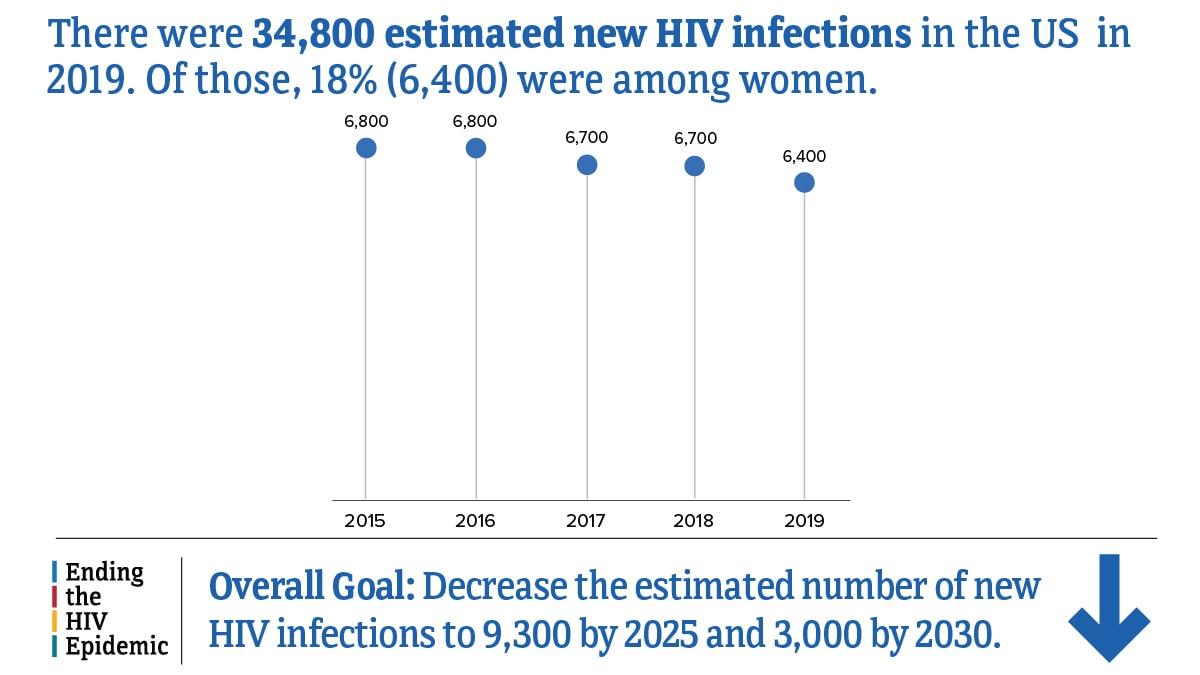
* Based on sex assigned at birth.
Source: CDC. Estimated HIV incidence and prevalence in the United States, 2015–2019. HIV Surveillance Supplemental Report 2021;26(1).
HIV diagnoses
HIV diagnoses refers to the number of people who received an HIV diagnosis during a given year.
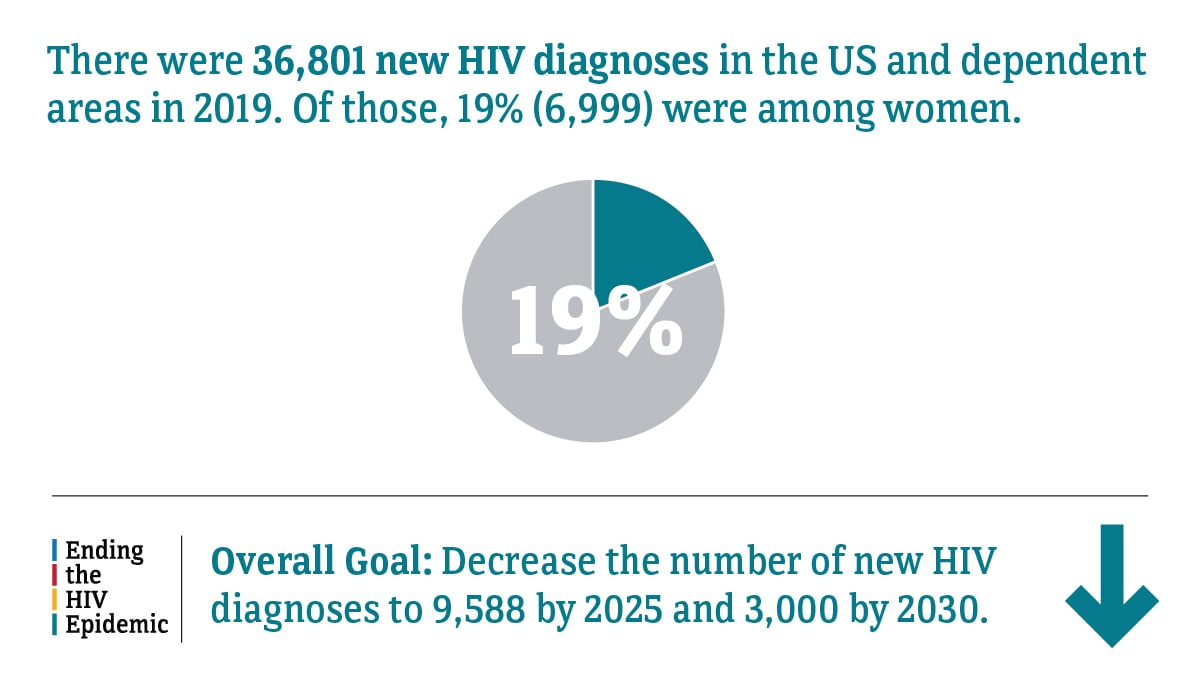
Source: CDC. Diagnoses of HIV infection in the United States and dependent areas, 2019. HIV Surveillance Report 2021;32.
HIV diagnoses among women by transmission category in the US and dependent areas, 2019*
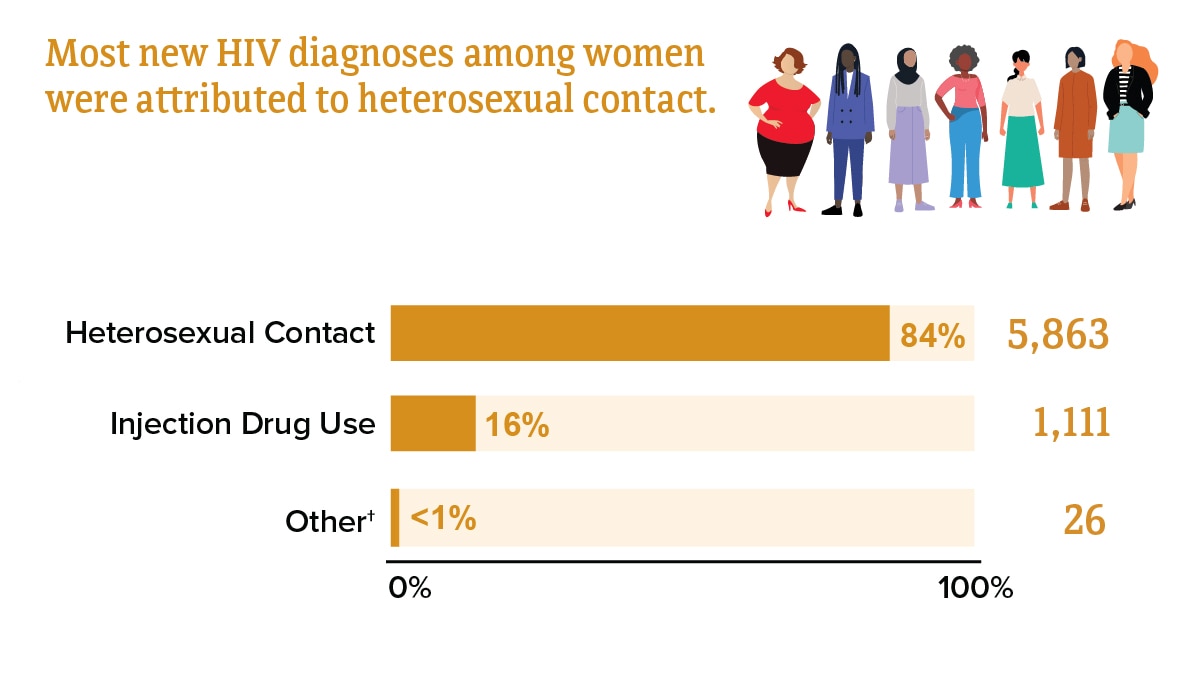
* Based on sex assigned at birth and includes transgender people. For more information about transgender people, visit CDC's Fast Facts: HIV and Transgender People web content.
† Includes perinatal exposure, blood transfusion, hemophilia, and risk factors not reported or not identified.
Source: CDC. Diagnoses of HIV infection in the United States and dependent areas, 2019. HIV Surveillance Report 2021;32.
HIV diagnoses among women by age in the US and dependent areas, 2019*
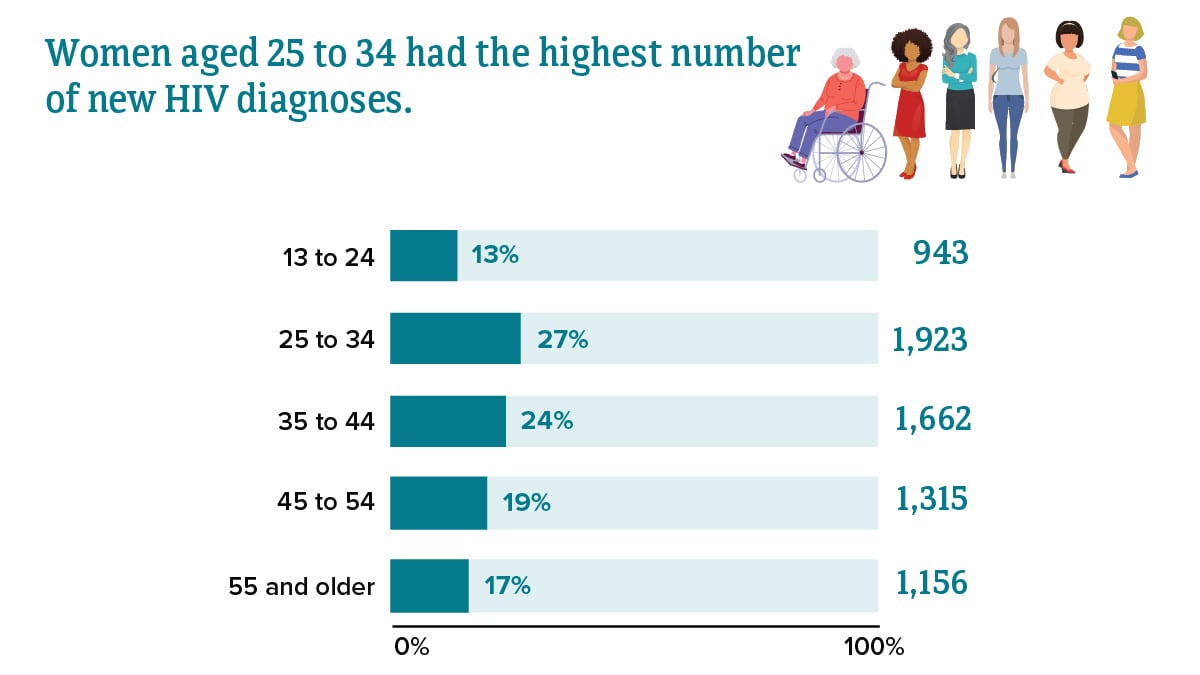
Total may not equal 100% due to rounding.
* Based on sex assigned at birth and includes transgender people. For more information about transgender people, visit CDC's Fast Facts: HIV and Transgender People web content.
Source: CDC. Diagnoses of HIV infection in the United States and dependent areas, 2019. HIV Surveillance Report 2021;32.
HIV diagnoses among women by race/ethnicity in the US and dependent areas, 2019*
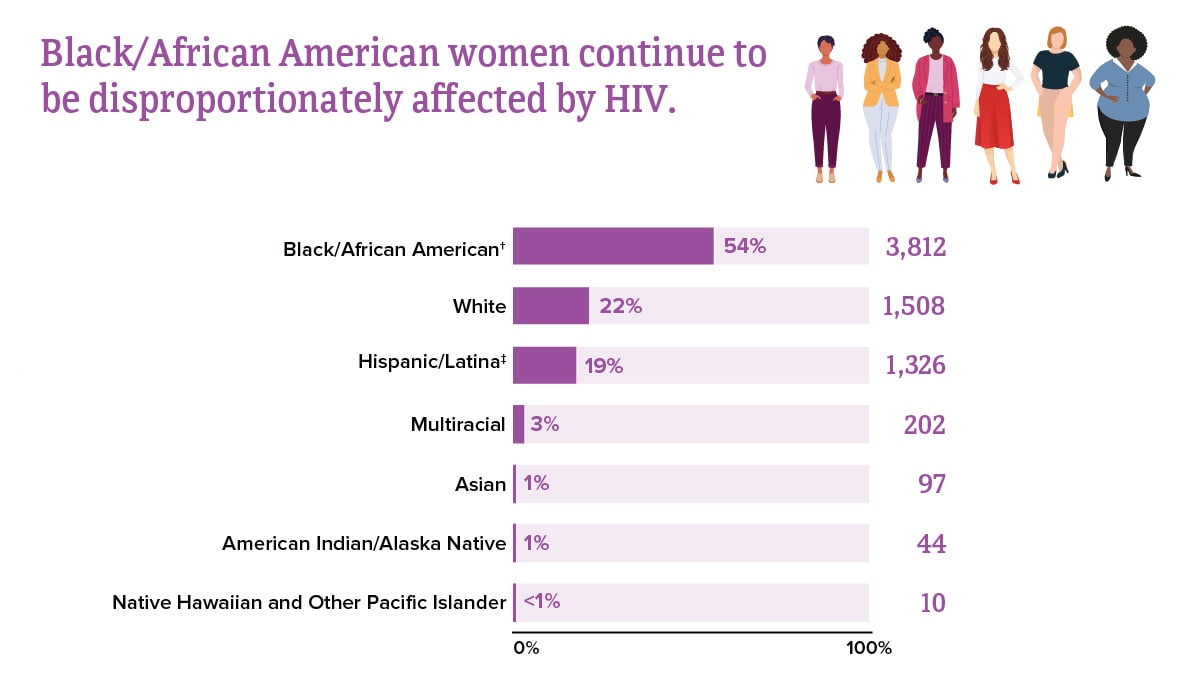
* Based on sex assigned at birth and includes transgender people. For more information about transgender people, visit CDC's Fast Facts: HIV and Transgender People web content.
† Black refers to people having origins in any of the Black racial groups of Africa. African American is a term often used for people of African descent with ancestry in North America.
‡ Hispanic/Latina women can be of any race.
Source: CDC. Diagnoses of HIV infection in the United States and dependent areas, 2019. HIV Surveillance Report 2021;32.
HIV diagnoses decreased 6% among women overall from 2015 to 2019. Although trends varied for different groups of women, HIV diagnoses declined for groups most affected by HIV, including Black/African American women and young women aged 13 to 24.
HIV diagnoses among women in the US and dependent areas, 2015-2019*
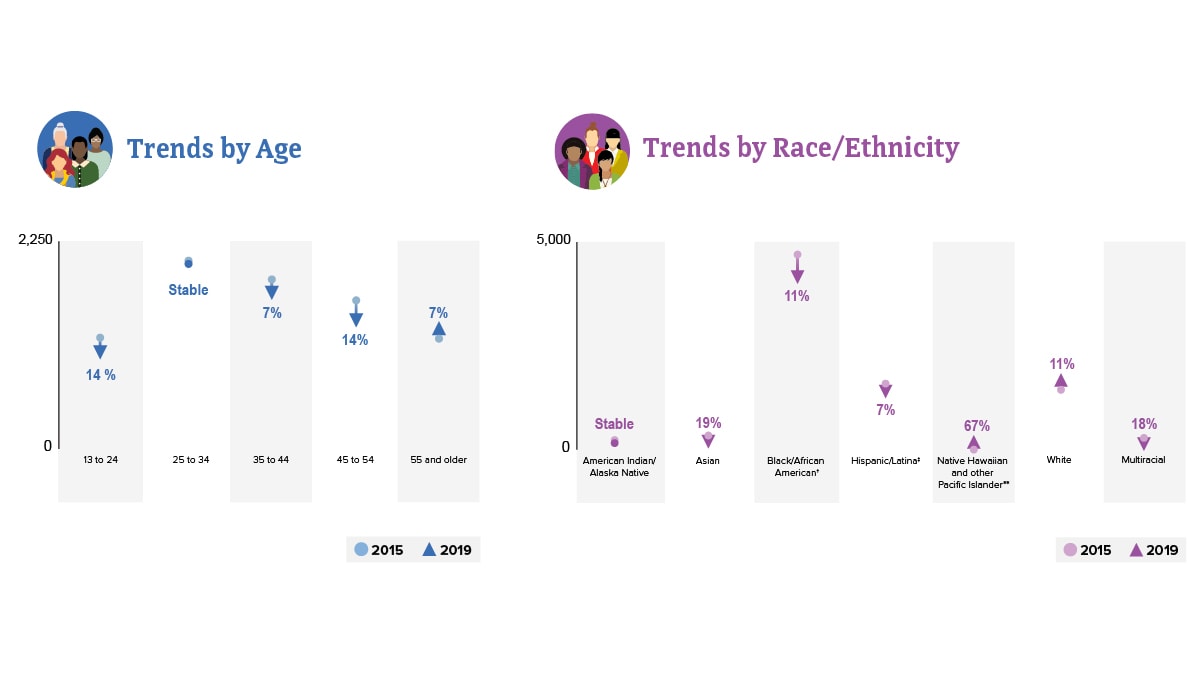
* Based on sex assigned at birth and includes transgender people. For more information about transgender people, visit CDC's Fast Facts: HIV and Transgender People web content.
† Black refers to people having origins in any of the Black racial groups of Africa. African American is a term often used for people of African descent with ancestry in North America.
‡ Hispanic/Latina women can be of any race.
** Changes in subpopulations with fewer HIV diagnoses can lead to a large percentage increase or decrease.
Source: CDC. Diagnoses of HIV infection in the United States and dependent areas, 2019. HIV Surveillance Report 2021;32.
Knowledge of status
Knowledge of status refers to the estimated percentage of people with HIV who have received an HIV diagnosis.
Women with HIV in the US, 2019*
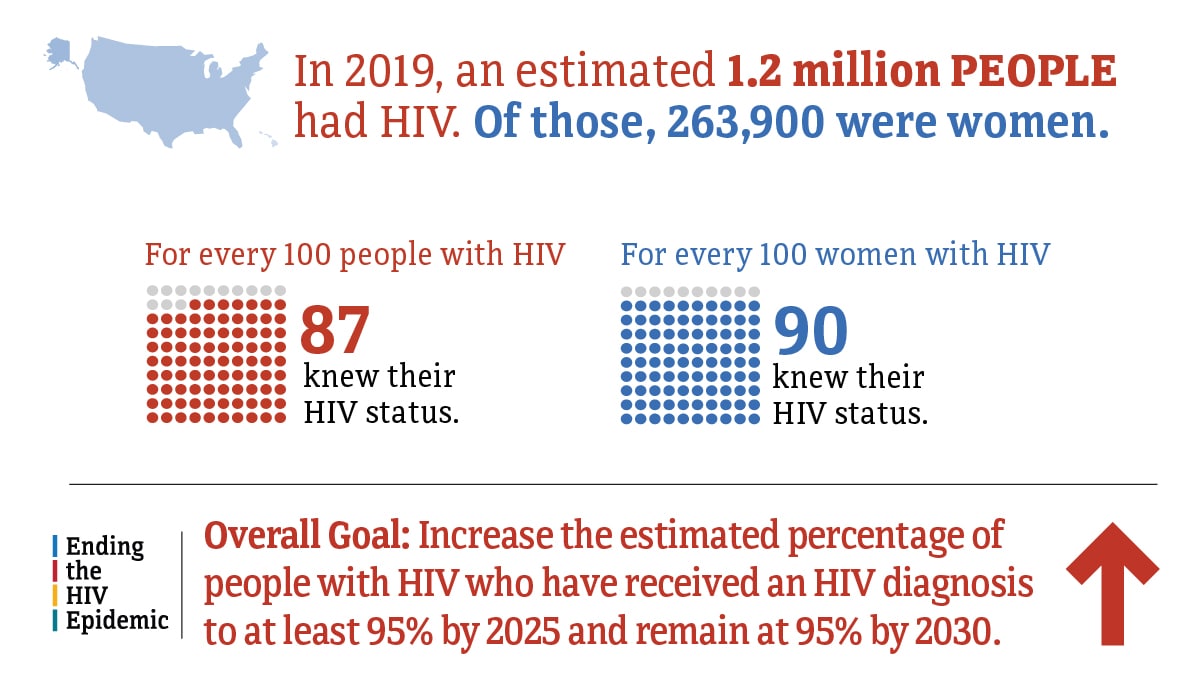
* Based on sex assigned at birth.
Source: CDC. Estimated HIV incidence and prevalence in the United States 2015–2019. HIV Surveillance Supplemental Report 2021;26(1).
Behaviors associated with HIV transmission
The chances of getting or transmitting HIV varies widely depending on the type of exposure or behavior. Most commonly, people get or transmit HIV through anal or vaginal sex, or sharing needles, syringes, or other drug injection equipment—for example, cookers.
Sexual behaviors among cisgender women* with diagnosed HIV in the US, 2020†
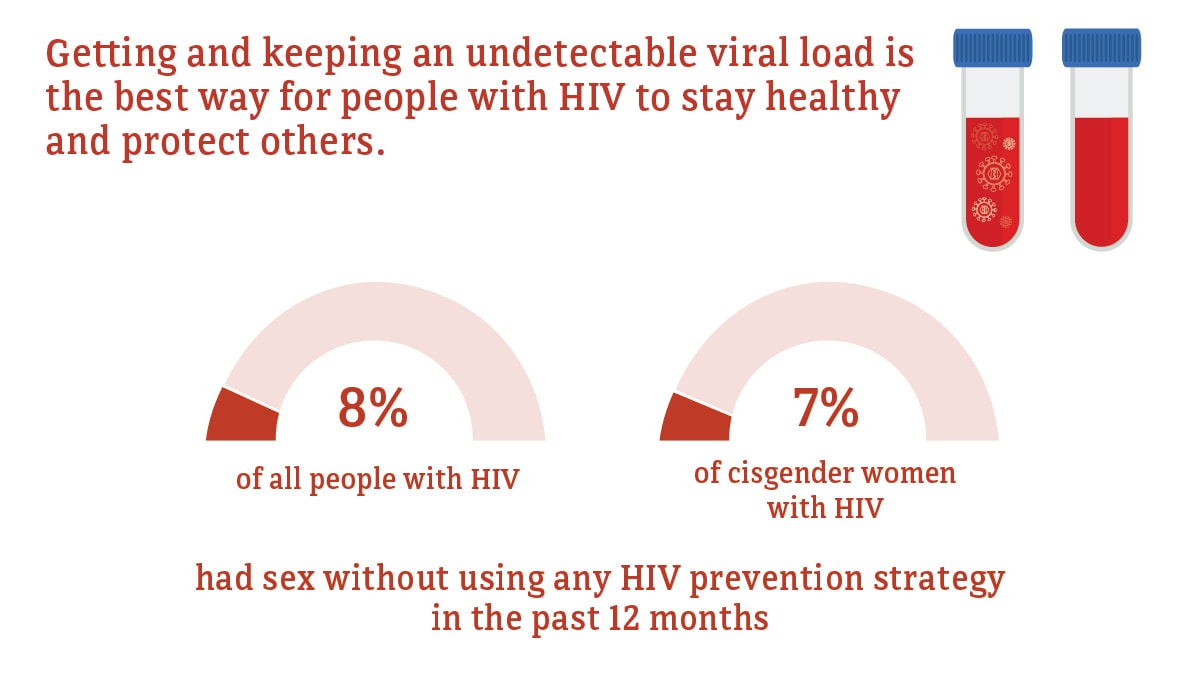
Data for transgender women are not included because the numbers are too small to report.
* The term cisgender women refers to people assigned female at birth who identify as female.
† Had sex while not virally suppressed with a partner whose HIV status was negative or unknown, a condom was not used, and the partner was not taking PrEP.
Source: CDC. Behavioral and Clinical Characteristics of Persons with Diagnosed HIV Infection—Medical Monitoring Project, United States, 2020 Cycle (June 2020–May 2021). HIV Surveillance Special Report 2022;29.
Injection behaviors among women who inject drugs in 23 US cities, 2018*
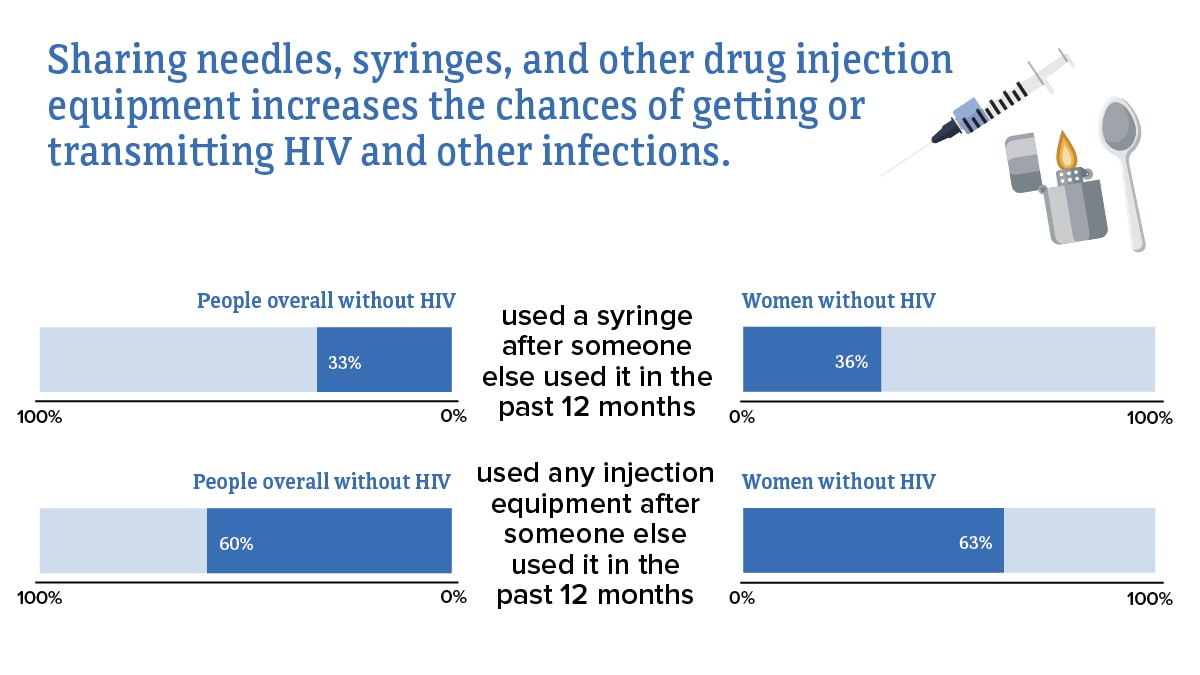
* Based on current gender identity.
Source: CDC. HIV infection risk, prevention, and testing behaviors among persons who inject drugs—National HIV Behavioral Surveillance: injection drug use, 23 U.S. Cities, 2018. HIV Surveillance Special Report 2020;24.
PrEP coverage
CDC has paused PrEP (pre-exposure prophylaxis) coverage reporting to determine the best methodology for calculating PrEP coverage, and to update PrEP coverage estimates using updated methods and sources. Due to a formula error that affects a subset of race and ethnicity data, all race and ethnicity data have been removed from this site. CDC plans to resume PrEP coverage reporting in the next HIV Monitoring Report for all demographic groups, currently scheduled for publication in June 2025. Until updated PrEP coverage estimates are published, CDC advises against citing specific PrEP coverage data points, as historical estimates will be updated..
Viral suppression and barriers to care
Viral suppression refers to the percentage of people with diagnosed HIV who have less than 200 copies of HIV per milliliter of blood.
HIV care continuum among women with diagnosed HIV in 44 states and the District of Columbia, 2019*
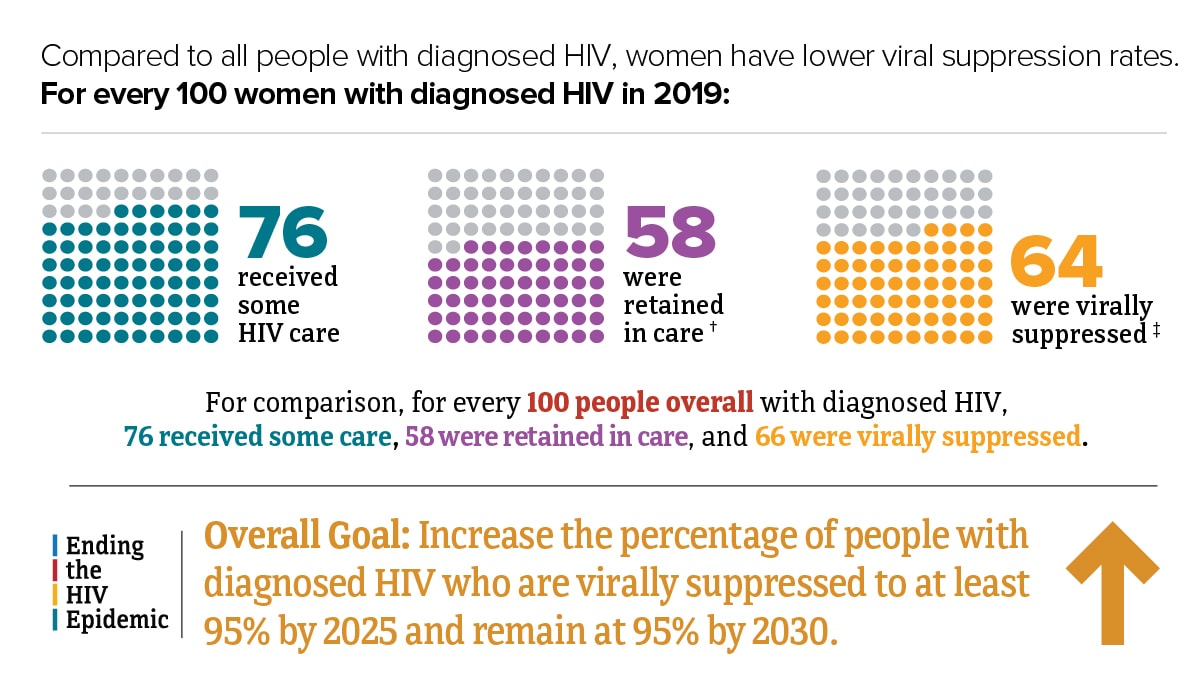
* Based on sex assigned at birth.
† Had 2 viral load or CD4 tests at least 3 months apart in a year.
‡ Based on most recent viral load test.
Source: CDC. Monitoring selected national HIV prevention and care objectives by using HIV surveillance data United States and 6 dependent areas, 2019. HIV Surveillance Supplemental Report. 2021;26(2).
Although many people taking HIV medicine are virally suppressed, some people with HIV are currently not virally suppressed or do not maintain viral suppression over time. Some challenges with achieving and maintaining viral suppression include missing multiple doses of HIV treatment, missing medical appointments, or needing other important health care services.
Missed HIV medical care appointments among cisgender women* with diagnosed HIV in the US, 2020†
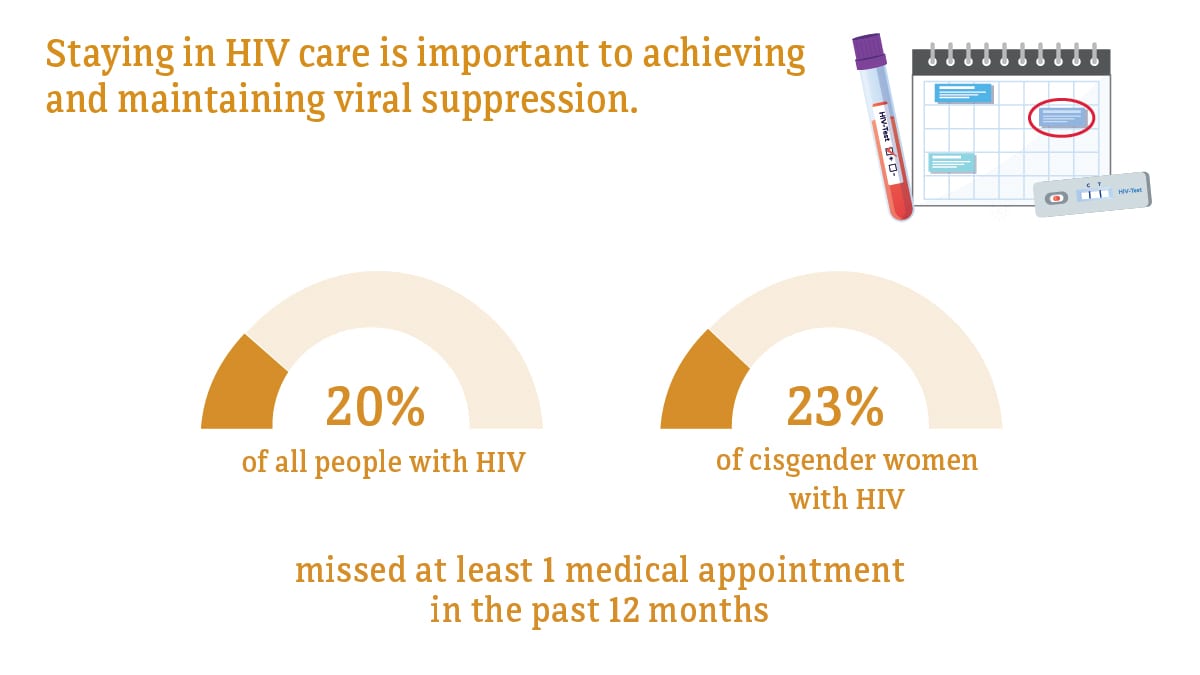
Data for transgender women are not included because the numbers are too small to report.
* The term cisgender women refers to people assigned female at birth who identify as female.
† Among people aged 18 and older.
Source: CDC. Medical Monitoring Project.
HIV treatment among cisgender women* with diagnosed HIV in the US, 2020†
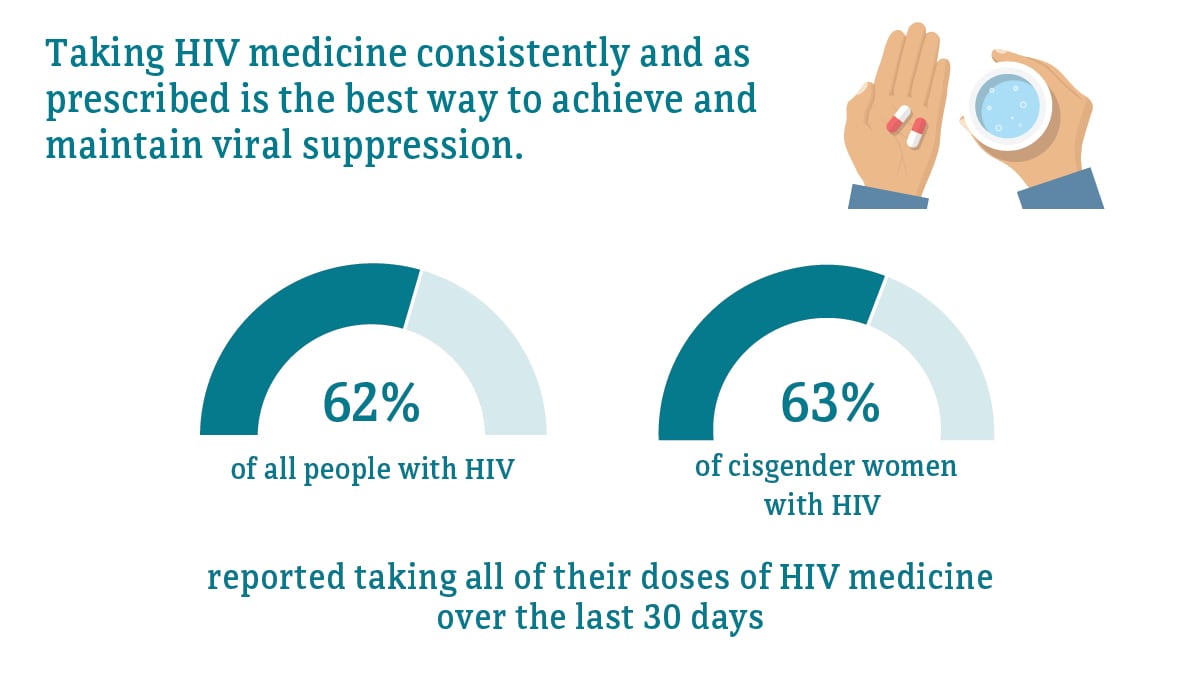
Data for transgender women are not included because the numbers are too small to report.
* The term cisgender women refers to people assigned female at birth who identify as female.
† Among people aged 18 and older.
Source: CDC. Medical Monitoring Project.
Needed HIV ancillary services among cisgender women* with diagnosed HIV in the US, 2020†‡
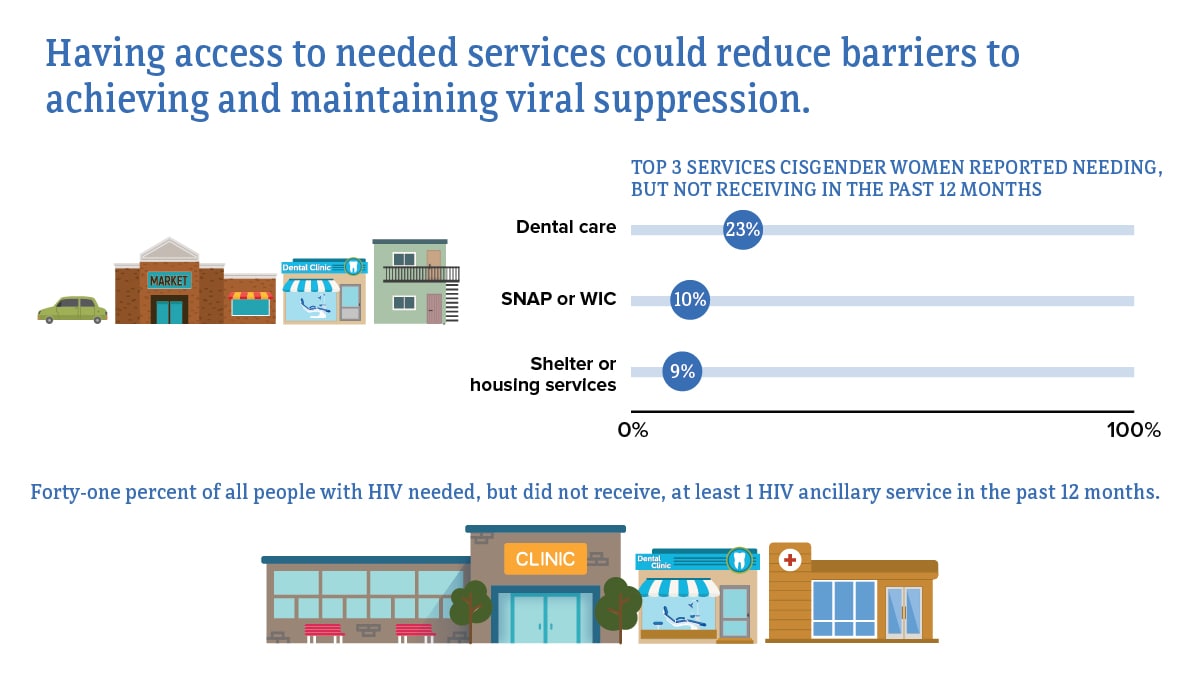
Abbreviations: SNAP = Supplemental Nutrition Assistance Program; WIC = Special Supplemental Nutrition Program for Women, Infants, and Children.
Data for transgender women are not included because the numbers are too small to report.
* The term cisgender women refers to people assigned female at birth who identify as female.
† Among people aged 18 and older.
‡ HIV ancillary services, such as case management and mental health services, are services that support retention in HIV care.
Source: CDC. Medical Monitoring Project.
Symptoms of depression and anxiety among cisgender women* with diagnosed HIV in the US, 2020†
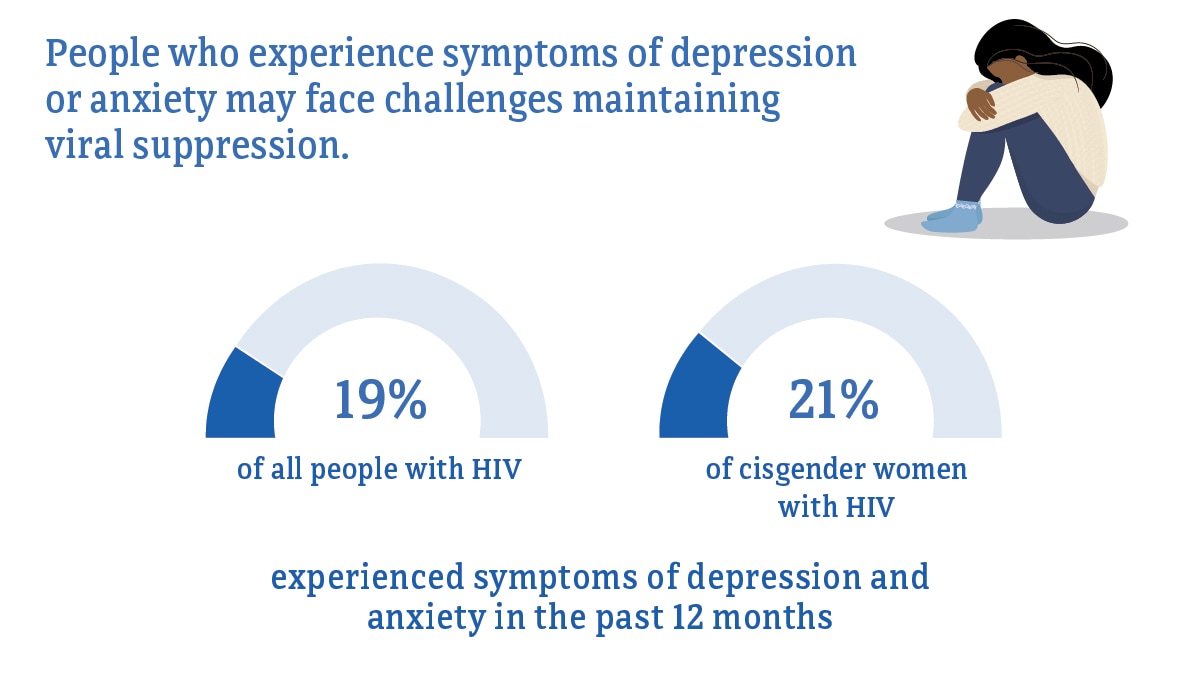
Data for transgender women are not included because the numbers are too small to report.
* The term cisgender women refers to people assigned female at birth who identify as female.
† Among people aged 18 and older.
Source: CDC. Medical Monitoring Project.
Social and economic issues—such as stigma and homelessness—have also prevented some women from getting the HIV care and treatment they need.
Homelessness among cisgender women* with diagnosed HIV in the US, 2020†
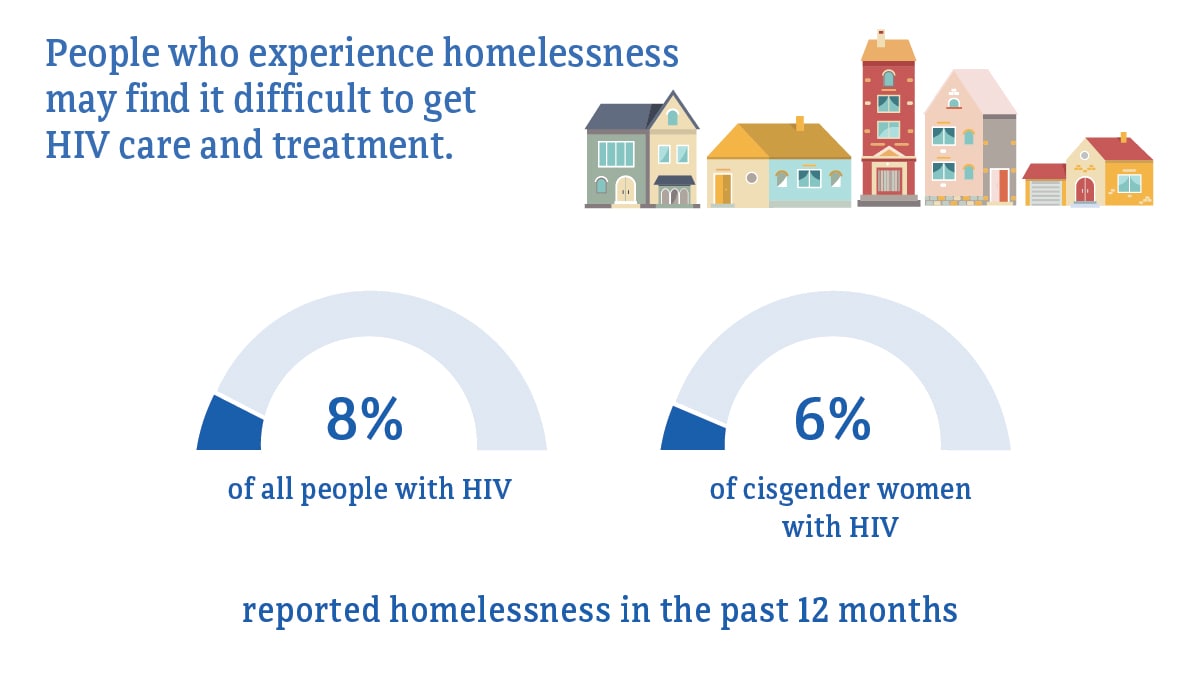
Data for transgender women are not included because the numbers are too small to report.
* The term cisgender women refers to people assigned female at birth who identify as female.
† Among people aged 18 and older.
Source: CDC. Medical Monitoring Project.
Median HIV stigma score among cisgender women* with diagnosed HIV in the US, 2020†
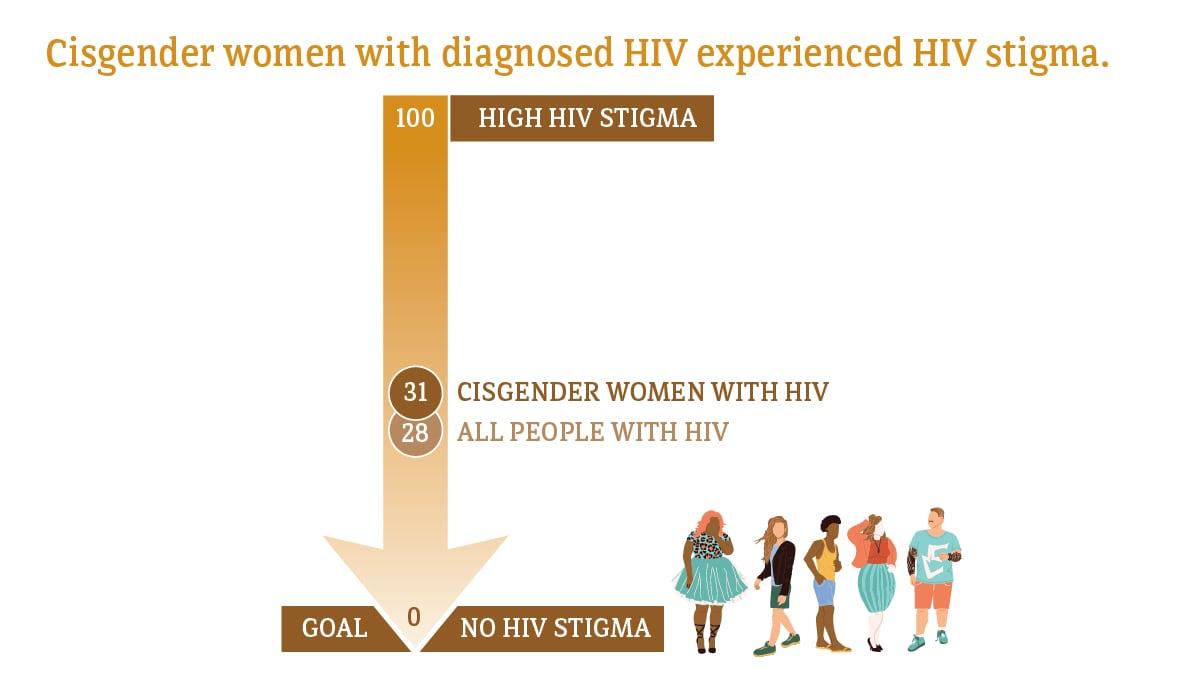
Data for transgender women are not included because the numbers are too small to report.
Median HIV stigma scores are presented based on a ten-item scale ranging from 0 (no stigma) to 100 (high stigma) that measures personalized stigma during the past 12 months, current disclosure concerns, current negative self-image, and current perceived public attitudes about people with HIV.
* The term cisgender women refers to people assigned female at birth who identify as female.
† Among people aged 18 and older.
Source: CDC. Medical Monitoring Project.
